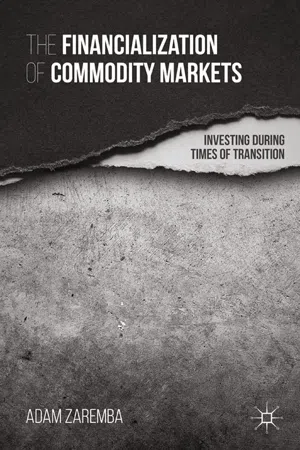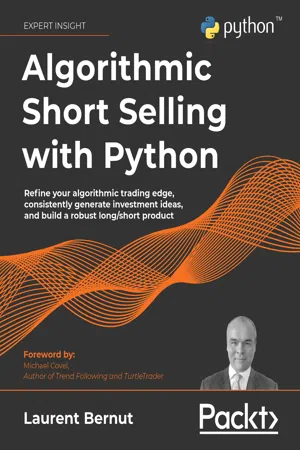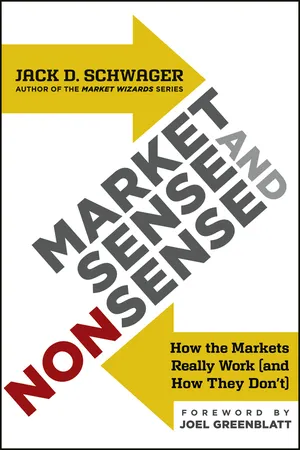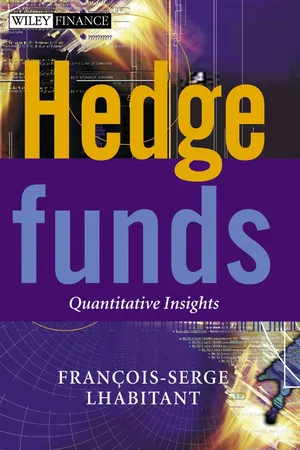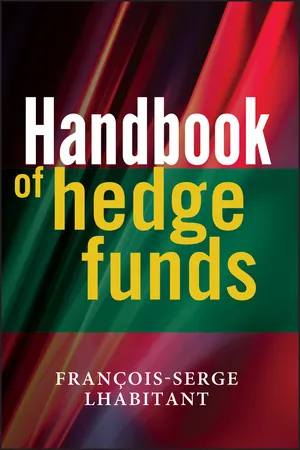Business
Sharpe Ratio
The Sharpe Ratio is a measure of risk-adjusted return, commonly used to evaluate the performance of an investment or portfolio. It calculates the excess return generated per unit of risk, with a higher ratio indicating better risk-adjusted performance. By considering both return and volatility, the Sharpe Ratio provides a valuable tool for comparing investment opportunities and assessing their risk-return tradeoff.
Written by Perlego with AI-assistance
Related key terms
Related key terms
1 of 4
Related key terms
1 of 3
7 Key excerpts on "Sharpe Ratio"
- eBook - ePub
The Financialization of Commodity Markets
Investing During Times of Transition
- A. Zaremba, Kenneth A. Loparo(Authors)
- 2015(Publication Date)
- Palgrave Macmillan(Publisher)
Then, the most important drawbacks of the described measures, which are most visible in the context of the subject being studied, are listed. Ultimately, the two new measures that are aimed at correcting the shortcomings of their predecessors are discussed. These measures are later used in the empirical study presented in chapter 6. 1 Sharpe Ratio William Sharpe, later a Nobel Prize winner, published a paper titled “Mutual Fund Performance” in 1966, in which he described an index that was later named after its creator. The Sharpe Ratio is still, without a doubt, the most popular investment performance measurement tool, which takes into account not only the profit, but also the risk. Traditional Definition In the most traditional approach, the Sharpe Ratio measures the excess rate of return per unit of risk taken by the investor (Sharpe 1966). The Sharpe Ratio is calculated by dividing the excess return and risk, understood as the volatility (standard deviation) 2 of rates of return, which is reflected in equation (12). where R p represents rate of return on the portfolio being evaluated during the relevant period, R F represents rate of return on a risk-free instrument, and σ p represents volatility of portfolio returns. All values are customarily given per annum. It is extremely important that the level of the Sharpe Ratio is dependent on the length of the analyzed period (time dependent). This is because, as the analyzed period gets longer, the expected rates of return grow linearly or exponentially and the standard deviation increases approximately in proportion to the square root of the period concerned (Lhabitant 2008b, p. 455) - eBook - ePub
Algorithmic Short Selling with Python
Refine your algorithmic trading edge, consistently generate investment ideas, and build a robust long/short product
- Laurent Bernut, Michael Covel(Authors)
- 2021(Publication Date)
- Packt Publishing(Publisher)
The Sharpe Ratio is such an intricate part of life in the industry that a mundane greeting such as "how are you?" could easily be interchanged with "how is your Sharpe?" The question the ratio is trying to answer is conceptually simple: for every unit of volatility, how many units of excess returns over a risk-free asset do you receive in return? Now, all the problems derive not from the formula, but from the meaning people have ascribed to volatility. Is volatility bad, risky, or uncertain?Here is the mathematical formula of the Sharpe Ratio, where Rp is equal to asset returns, and Rf is equal to risk-free returns:This ratio looks at the annualized average excess returns over a risk-free asset divided by the standard deviation of those returns. Standard deviation measures the variance from the median returns. The more volatile the returns, the higher the standard deviation, and the lower the ratio (and vice versa). The excess returns over a risk-free asset is a simple test: for every additional unit of volatility, are you better off parking money with a specific manager or keeping it safe with T-bonds or money market funds?Even the genius William Sharpe has become critical of the measure he created and that has now become the default industry standard: the Sharpe Ratio. This metric served its purpose. There are two things it did really well:- Cross-asset unified measure : it is now widely accepted that the most critical component in alpha generation is asset allocation. The difficulty is to have a unified risk-adjusted measure of alpha across asset classes. This is where the Sharpe Ratio did the job. It can be calculated across fixed income, equities, commodities, and so on.
- Uncertainty : the human brain is hardwired to associate uncertainty with risk. It triggers the amygdala and activates the fight, flight, or freeze reflex.
Now, the Sharpe Ratio was invented in 1966. It was revolutionary in revolutionary times: El Che Guevara and Fidel Castro were still fighting Batista in Cuba. As the pioneer William Sharpe himself said, it was good when computing power was still limited. But since then, times have changed. Doctors have stopped prescribing cigarettes to pregnant women, plastic has become the dominant marine species, and computers more powerful than those that sent people to the moon now fit in everyone's pocket. - eBook - ePub
- (Author)
- 2023(Publication Date)
- Wiley(Publisher)
In this reading, performance appraisal is based only on the CAPM. However, it is easy to extend this analysis to multi-factor models that may include industry or other special factors. Four ratios are commonly used in performance appraisal.11.1. The Sharpe Ratio
Performance has two components, risk and return. Although return maximization is a laudable objective, comparing just the return of a portfolio with that of the market is not sufficient. Because investors are risk averse, they will require compensation for higher risk in the form of higher returns. A commonly used measure of performance is the Sharpe Ratio , which is defined as the portfolio’s risk premium divided by its risk. An appealing feature of the Sharpe ratio is that its use can be justified on a theoretical ex ante (before the fact) basis and ex post (after the fact) values can easily be determined by using readily available market data. The Sharpe ratio is also easy to interpret, essentially being an efficiency ratio relating reward to risks taken. It is the most widely recognized and used appraisal measure.The equation below defines the ex ante Sharpe ratio in terms of three inputs: (1) the portfolio’s expected return, E(Rp ); (2) the risk-free rate of interest, Rf ; and (3) the portfolio’s ex ante standard deviation of returns (return volatility), σ p , a quantitative measure of total risk.SR =E(−)R pR Fσ pThe Sharpe Ratio can also be used on an ex post basis to evaluate historical risk-adjusted returns. Assume we have a sample of historical data that can be used to determine the sample mean portfolio return,; the standard deviation of the sample returns, here denoted byR ¯p(sp is a familiar notation in other contexts); and the sample mean risk-free rate,pσ ^. The ex postR ¯f - eBook - ePub
Market Sense and Nonsense
How the Markets Really Work (and How They Don't)
- Jack D. Schwager(Author)
- 2012(Publication Date)
- Wiley(Publisher)
Reality: Return alone is a meaningless statistic because return can always be increased by increasing risk. The return/risk ratio should be the primary performance metric.Investment Misconception 24: For a risk-seeking investor considering two investment alternatives, an investment with expected lower return/risk but higher return may often be preferable to an equivalent-quality investment with the reverse characteristics.Reality: The higher return/risk alternative would still be preferable, even for risk-seeking investors, because by using leverage it can be translated into an equivalent return with lower risk (or higher return with equal risk).Investment Misconception 25: The Sharpe Ratio is the best choice for a return/risk measure.Reality: The Sharpe Ratio is the most widely used return/risk measure, but because it does not distinguish between upside and downside volatility, many of the alternative return/risk measures detailed in this chapter are more consistent with the way most investors perceive risk.Investment Misconception 26: If the Sortino ratio is higher than the Sharpe Ratio, it implies that the manager’s return distribution is right-skewed (wide upside deviations are more probable than wide downside deviations).Reality: The formula for calculating the Sortino ratio is biased to yielding a higher value than the Sharpe Ratio. The return/risk measure based on downside risk that can be directly compared with the Sharpe Ratio is the symmetric downside-risk (SDR) Sharpe Ratio (using the average return as the benchmark). An SDR Sharpe Ratio that is significantly higher than the Sharpe Ratio would imply that returns are right-skewed.Investment Misconception 27: The maximum drawdown is one of the most important risk measures. Reality: - eBook - ePub
The Investment Advisor Body of Knowledge + Test Bank
Readings for the CIMA Certification
- (Author)
- 2015(Publication Date)
- Wiley(Publisher)
The Modified Sharpe Ratio is a measure of excess portfolio returns to risk where both excess returns and risk are defined relative to a benchmark portfolio. Specifically, the Modified Sharpe Ratio measures the average portfolio returns less the average benchmark portfolio returns per unit of tracking error:(8.18)This measure of risk offers a reasonably complete picture of the average benchmark-relative returns per unit of benchmark-relative total risk. It can be interpreted as the reward per unit of risk of investing in the actual portfolio rather than in the benchmark. Indeed, the traditional Sharpe Ratio is actually a special case of the Modified Sharpe Ratio where the benchmark portfolio is just a Treasury bill portfolio.The Modified Sharpe Ratio can be extremely useful in comparing the performance of alternative investment portfolios. Unlike a simple comparison of two actual Sharpe Ratios, the Modified Sharpe Ratio takes into consideration the common factors that may be influencing risk and return in both portfolios. Like the Sharpe Ratio, however, the Modified Sharpe Ratio is a total risk performance measure. Because total risk includes both systematic and idiosyncratic risk, the Modified Sharpe Ratio may be less appropriate for investors who hold shares in a large number of different, diversified portfolios—that is, for investors whose idiosyncratic risks are largely diversified away. Also, like the Sharpe Ratio, variance remains the sole statistical summary of risk; asymmetric distributions and fat tails are therefore ignored.It is worth noting the close similarity between the Modified Sharpe Ratio and the statistic commonly used for tests of significance—the t-statistic. If the denominator of the Modified Sharpe Ratio, the tracking error, is adjusted for (divided by) sample size, the result is the standard error or the mean:(8.19)The t-statistic measures excess returns divided by the standard error of the mean:(8.20)Although the original Sharpe Ratio can be used for an ex post risk-adjusted performance measure, the t - eBook - ePub
Hedge Funds
Quantitative Insights
- François-Serge Lhabitant(Author)
- 2009(Publication Date)
- Wiley(Publisher)
Table 4.9 shows the RoVaR of our five funds using a one-month historical value at risk calculated at 99% and at 95% confidence. Once again, the ranking differs, because the risk definitions are different.Box 4.4In the case of normally distributed returns, it is relatively easy to express the RoVaR of a portfolio as a function of the Sharpe Ratio, as the VaR typically depends on the mean return (RP ) and on the volatility of the portfolio (σP ). More precisely: where -k is the standard normal variable reflecting the confidence level on which the VaR is predicated (for example, k = -1.645 if we have a 95% confidence level). It follows that: Using equation (4.1) to replace RP , we obtain This shows that there is a link between the RoVaR and the Sharpe Ratio. It also evidences that we should not expect the same ranking of funds from both measures. As an illustration, if the risk-free rate RF is zero, we have: As k can take any value, there is no reason for the RoVaR and the Sharpe Ratio to provide equal rankings.4.5 CONCLUSIONS
Over the last few decades, a number of sophisticated measures have been developed to monitor the risk-adjusted performance of hedge funds. These measures have much in common as regards their underlying framework and financial intuition, but they rely on different calculation techniques and parameters. Hence, when applied to a series of hedge funds, they often produce different rankings.From the performance evaluator’s point of view, this array of performance measures offers a rich choice but at the same time makes the selection of a method difficult - if at all possible. Not surprisingly, for some years, unscrupulous product marketers have taken advantage of this difficulty. They simply considered hedge fund performance measurement as a game, following one guiding principle: “Give me a fund and I will find the performance measure and the time period that makes it look attractive.” - eBook - ePub
- François-Serge Lhabitant(Author)
- 2011(Publication Date)
- Wiley(Publisher)
is the average of the most significant drawdowns during the observation period. What is meant by a “significant” drawdown remains to be defined. Some analysts use the maximum drawdown rather than the average drawdown.Burke (1994) proposed using the square root of the sum of the squares of each drawdown, in order to penalize deep extended drawdowns as opposed to numerous mild ones. The Burke ratio is defined as(20.28)20.4.4 Return on VaR (RoVaR)
Another measure that is popular particularly among practitioners is the return on value at risk, or RoVaR (Box 20.4). This is defined simply as the return on the portfolio (RP) divided by the absolute213 value at risk (VaRP ).(20.29)Box 20.4 Return on Value at Risk (RoVaR)In the case of normally distributed returns, it is relatively easy to express the RoVaR of a portfolio as a function of the Sharpe Ratio, as the VaR typically depends on the mean return (RP ) and on the volatility of the portfolio (σP ). More precisely,where -k is the standard normal variable reflecting the confidence level on which the VaR is predicated (for example, k = −1.645 if we have a 95% confidence level). It follows that:VaRP = — (RP + kσP )Using equation (20.1) to replace RP , we obtainThis shows that there is a link between the RoVaR and the Sharpe Ratio. It also evidences that we should not expect the same ranking of funds from both measures. As an illustration, if the risk-free rate RF is zero, we have:As k can take any value, there is no reason for the RoVaR and the Sharpe Ratio to provide equal rankings.Table 20.9RoVaR ratio calculations for our five different hedge funds. All data are annualizedAs in the case of the Sortino ratio, the RoVaR ratio can be customized to cater for different holding periods as well as different level of confidence for the VaR. As an illustration, Table 20.9
Index pages curate the most relevant extracts from our library of academic textbooks. They’ve been created using an in-house natural language model (NLM), each adding context and meaning to key research topics.
Explore more topic indexes
Explore more topic indexes
1 of 6
Explore more topic indexes
1 of 4
